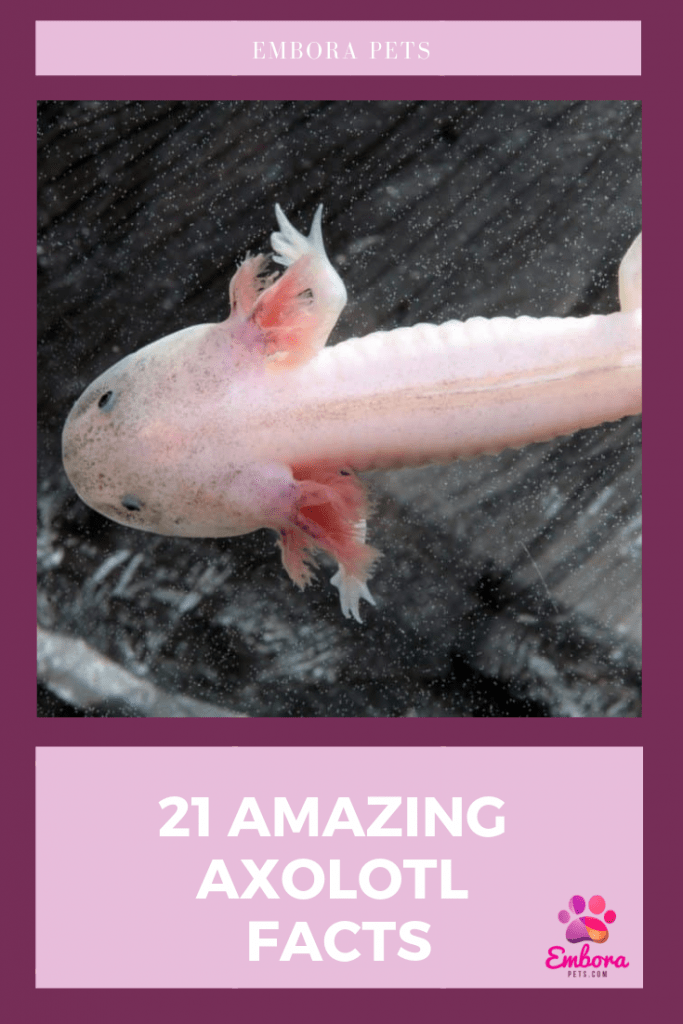21 Amazing Axolotl Facts
The Axolotl seems to be an extremely exotic animal and I have some incredible facts about them that you might not have heard of. If you have ever wanted to be a master of axolotl trivia, you’ve come to the right place. Below is a list of 21 of the coolest facts about these little creatures!
- They Have Strong Resistance to Cancer
- They Can Regenerate Parts of Their Body
- Its Skeleton is Cartilage
- They Weigh Less Than a Pound
- Its Egg Capacity Caps at 1,000
- They Do Not Have Eyelids
- They Communicate with Chemical Cues
- Their Gills are External
- They Also Have Lungs, Despite Being Water-Based Animals
- They are Critically Endangered
- Young Axolotls are Cannibalistic
- It is Not a Fish, But an Amphibian
- They Can Reach Adulthood without Experiencing Metamorphosis
- As Adults, They Look Like Larvae
- Water is the Only Place They Can Live
- Axolotls are Carnivores
- The Name “Axolotl” Has History in Mythology
- Axolotls Were a Source of Food and Medicine Anciently
- They Prefer the Night
- They are Solitary Creatures
- They are Normally Darker Colored
BONUS: You Can Have an Axolotl as a Pet
In the research I have done, I have found that there is a TON of misinformation. Because of that, I will provide links to source my facts. I will do my best to have them be scientific or a reputable source. I hope you enjoy the facts I share about these wonderful creatures!
1. They Have Strong Resistance to Cancer
Because of their ability to regenerate cells in their bodies, they are more than 1,000 times more resilient against cancer than mammals, like ourselves. How INCREDIBLE is that? Can you imagine?
Axolotls are basically “immortal.” Move over, Deadpool! We got an axolotl in the house! But in all seriousness, these creatures are kind of the Holy Grail of cell regeneration.
I won’t try to get into the specifics of the proteins and cells and whatnot, but I will explain a little bit of the process in the next section.
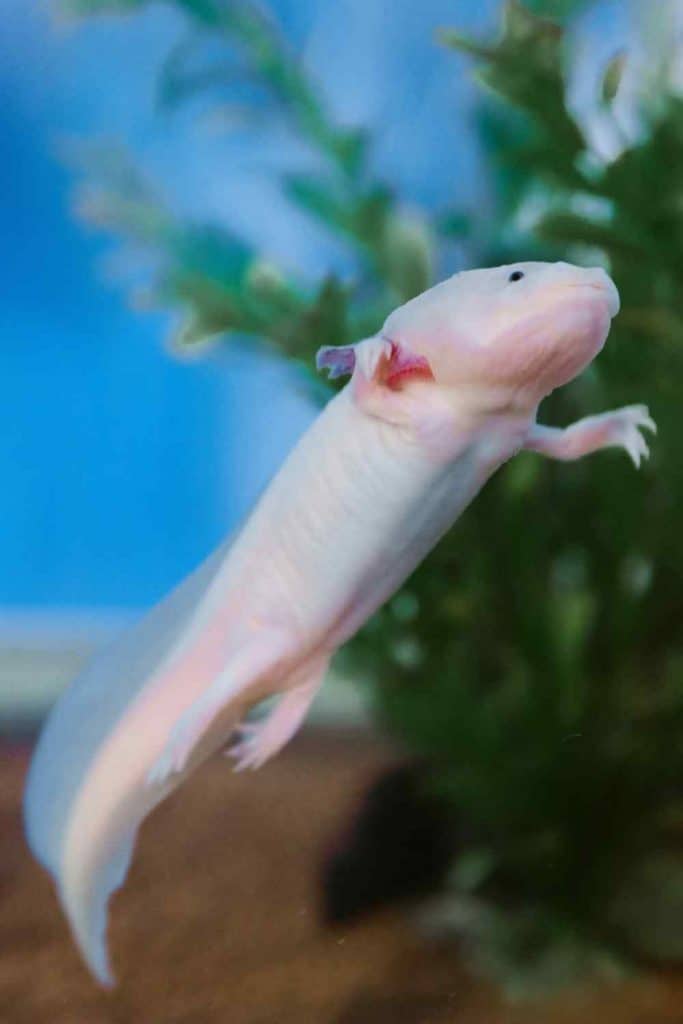
2. They Can Regenerate Parts of Their Body
Did you know that axolotls can regenerate parts of their brain? or even their spinal cord? Legs? Tail? Organs? Well, they can and it is pretty incredible.
“You can cut the spinal cord, crush it, remove a segment, and it will regenerate.”
Stephane Roy, Professor at University of Montreal
One of the main components of the cell regeneration in Axolotls is the Transforming Growth Factor beta one (TGF-β1). What a weird name right?
Well, in 2006, Stephane Roy, a Professor at Univerisity of Montreal, monitored the TGF-β1 levels during a period of limb regeneration in an axolotl. He noticed that the TGF-β1 levels were much higher during the first 48 hours after losing a limb and when the TGF-β1 was blocked, the limb regeneration did not occur.
Here is an awesome video that shows how we are using this knowledge to eventually help humans:
There is still much to be learned and studied about cell regeneration. Maybe one day we will understand enough to help humans and our quest to stop cancer. Who knows? Maybe we will be able to regenerate limbs too.
3. Its Skeleton is Cartilage
The axolotl’s skeleton is not completely firm. This is similar to cartilaginous fish who also do not have completely firm bodies. A lot of it stays cartilage, like your ears and part of your nose. Generally, when something matures, the bones become firmer and solid but because axolotls hold onto parts of their larvae stage, their bones do not completely calcify.
Their teeth, on the other hand, are solid. They are fine, sharp teeth used for puncturing prey, but they mostly swallow food whole. Even their gills are made of cartilage. They aren’t very heavy either and this could play a huge part in that.
4. They Weigh Less Than a Pound
One of the craziest things about the axolotl is how light it is. This thing weighs in at 8 ounces, 226.7 grams or 1/2 pound. That is INCREDIBLE! How does that even happen?
I could not find any exact information on this question in my searching but I would wager it is because the axolotl’s bones are mostly cartilage. It stays in its baby form, or rather larvae form. I would imagine that this makes it lighter. Plus they aren’t very big so it stands to reason why they are nearly weightless.
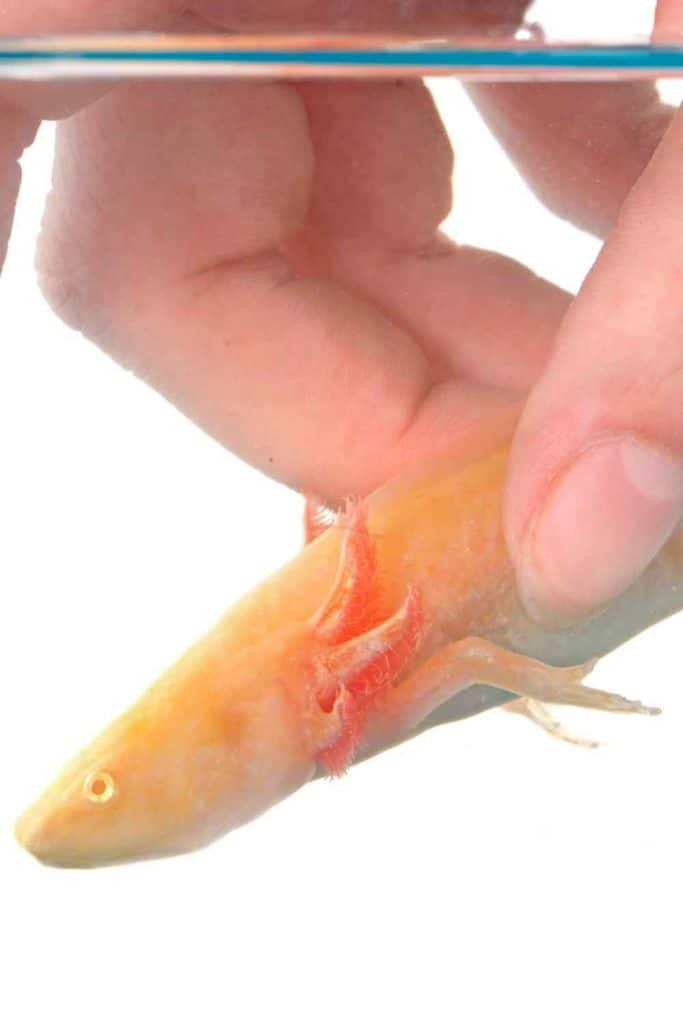
5. Its Egg Capacity Caps at 1,000
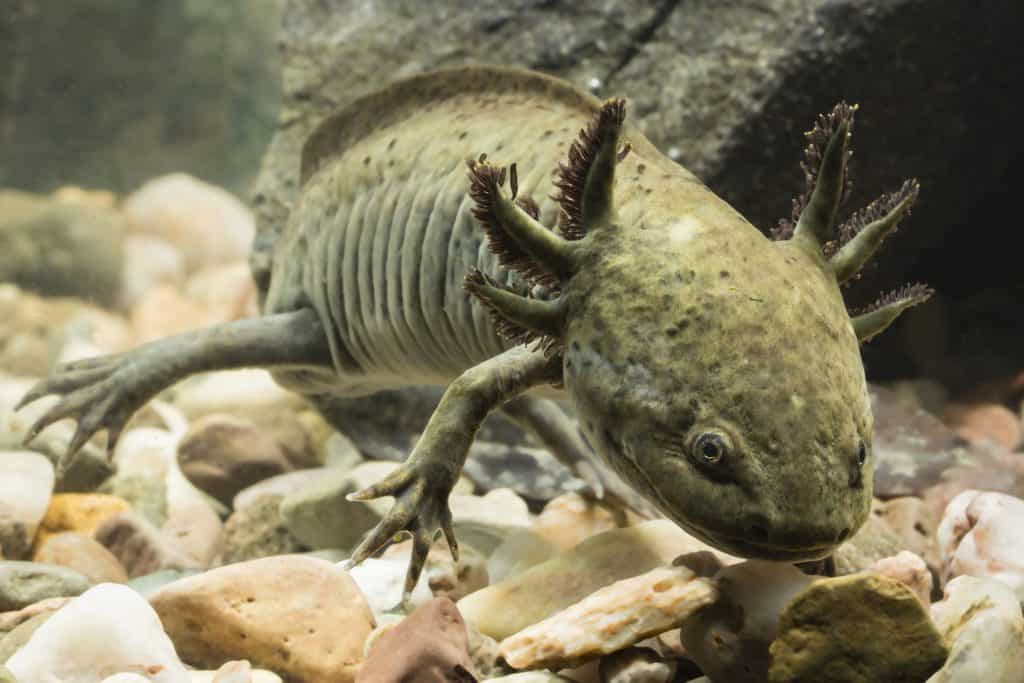
Most amphibians lay anywhere from 1 to 450 eggs, but the axolotl decided it would be different by laying eggs from about 100 to 1,000! That is at a single time, not over its lifespan.
With a egg capacity of that, you might be wondering why there aren’t more of them. Let me help answer that.
They live in one lake near Mexico City. Many of the eggs get eaten by the invasive species that were put there by humans. Another problem is the quality of life and health in the axolotls is dwindling as you read this. Many of the axolotls do not get a good chance at life.
6. They Do Not Have Eyelids
I do not know how they cope without them. Eyelids are something that amphibians gain from metamorphosis. Once they come on land, they develop them. Axolotls never grow eyelids because they never go through metamorphosis. They never leave their watery home.
Some people have stated that they have seen their “axies” (that’s the affectionate name given them) blink but that means they are either undergoing metamorphosis, which is unusual.
Something more plausible is that when they eat, they commonly pull their eyes inward as they move the muscle of their mouth around to swallow their food. Weird, right?
7. They Communicate with Chemical Cues
Axolotls communicate through visual means. When mating they communicate through chemical cues. Besides that, they don’t use a whole lot of communication. These are meant to perceive and understand their surrounding. They can even be used in finding prey.
They are pretty peaceful creatures that do not make a big fuss out of things. If you want to own one, they are not much a hassle.
8. Their Gills are External
Something I find interesting about these animals is they are somewhere between a fish and an amphibian. Now, scientifically they are considered amphibians. They are just unique in that they don’t go through metamorphosis.
They do not go from tadpoles in the water to adults on land. They mature right in the water and retain their larvae looking form. This is incredible and not a common thing in the slightest.
Because of all this, they live in the water and because they live in the water, they need gills to breathe. Fish have gills and they breathe through them, but they are internal. These little guys have gills on the outside.
The gills almost look like branches and these branches have a membrane that allows the oxygen in the water to pass through and then releases the carbon dioxide into the water from their body. The gills are connected straight to the arteries so once the oxygen goes through the membrane, it goes straight to the blood.
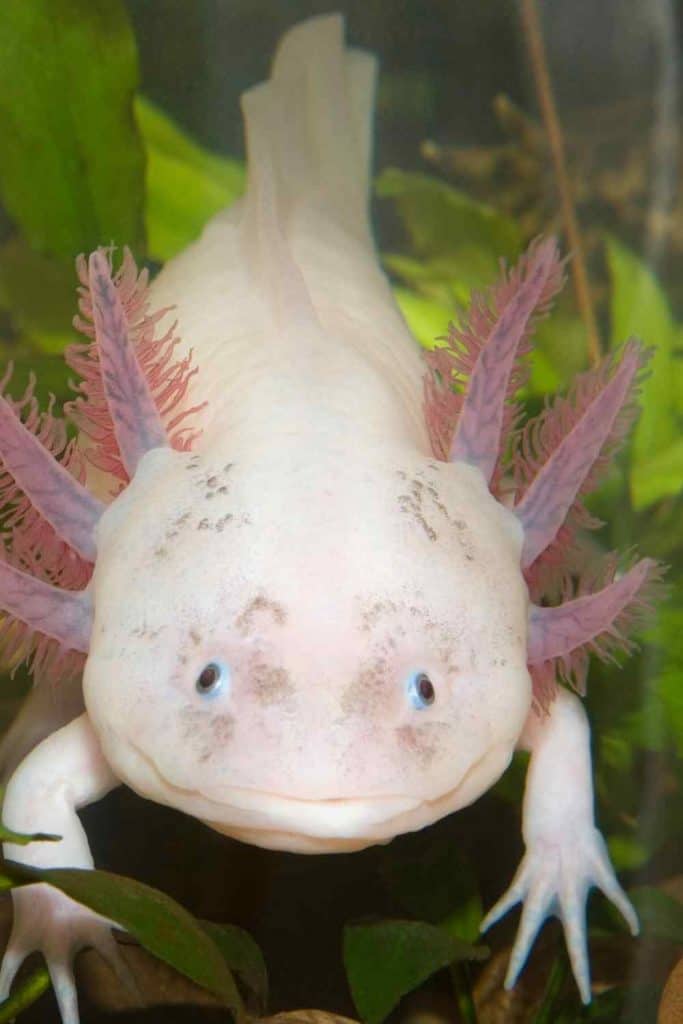
9. They Also Have Lungs, Despite Being Water-Based Animals
Even though these animals are water-based, they grow lungs and use them. Although, they primarily use their gills for breathing. But that is not all. There are 4 ways that they breathe:
- Lungs
- Gills
- Back of Throat
- Skin
Even though their bodies are obviously still wanting to grow like it is meant to go through metamorphosis, they do not. But some of the parts still remain of what could have been.
Lungs
I figured that we would start with the easiest first. Breathing through the lungs is something we all can relate to. The difference is that they do not use this as the primary source for oxygen.
They develop their lungs at about 3 weeks after birth around the same time that they develop hind legs. They use their lungs as a support when the oxygen level in the water gets too low. Sometimes they even just use them because they can and not in any particular situation.
A fun fact about them is that they love to go to the surface and gulp bubbles of air. They are playful creatures. I bet that is a sight to see.
Gills
The gills are the main source of gathering and “harvesting” oxygen for axolotls. The fancy outfit on their head are their gills. The gills branch out and contain capillaries called Fimbrea. These are connected directly to the arteries. The membranes filter the oxygen and put it directly into the bloodstream and release carbon dioxide into the water.
They flick their gills about to capture oxygen and move the carbon dioxide off of the gills. Doing this stirs the water around it and creates a good exchange of gases, which is really genius. They are incredibly efficient at this.
Back of the Throat
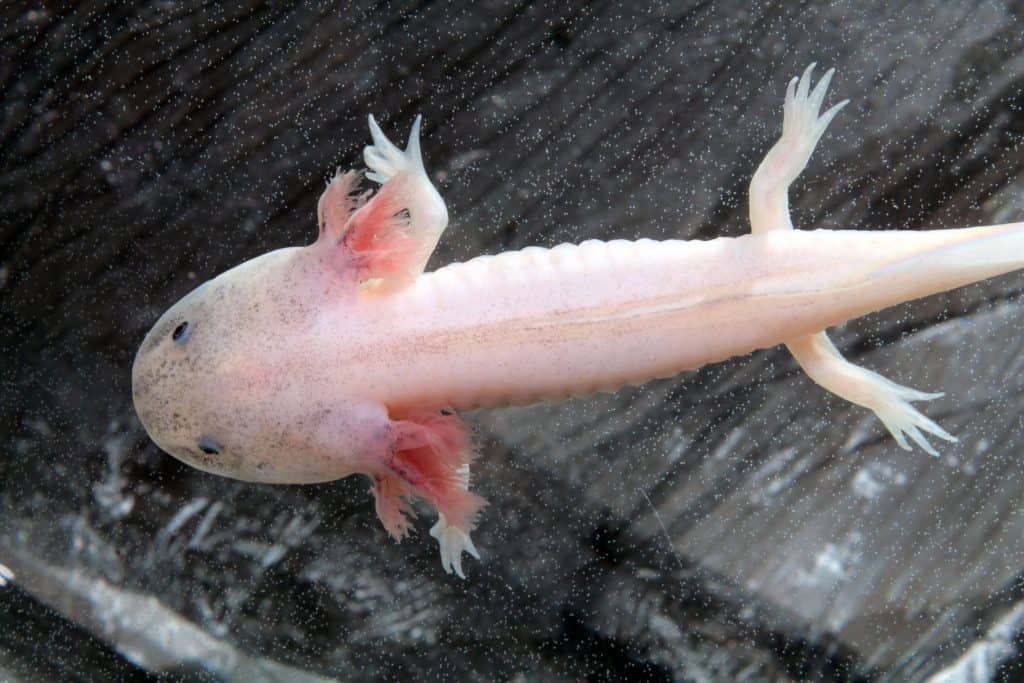
This is the most bizarre of the bunch. You would think that the lungs were enough but nope! The Back of the throat works as well, because why not?
Let’s get into the big words and science of it. The axolotls use a membrane called the “Buccopharyngeal membrane” in the back of their throat to breathe. Scientists called this “Buccal respiration.” There is a skin flap in this area that let’s water pass through. As the throat expands and contracts, the oxygen in the water passes through the membrane.
Skin
And the last one of the bunch is the skin! Think about that, they can breathe through their skin. What an interesting concept. This type of breathing also has a name: “Cutaneous respiration.”
What this means is literally breathing directly through the skin. That’s all. Having stayed in their larvae stage, their skin is extra smooth and thin. Because of this, the gases can seep right through.
10. They are Critically Endangered
There are only between 700 and 1,200 axolotls left in the wild. That is an extremely low number when you compare it to other animals. That’s only a handful and they live in Lake Xochimilco near Mexico City. This is the only place they are found in the entire world.
In 1998, there were approximately 1,500 axolotls per square mile but now it’s about only 25 per square mile. That is ludicrous.
Why is this? Why are they so vastly in danger? One of the big reasons is habitat loss. I said before that they live in Lake Xochimilco but they also used to live in Lake Chalco about 10 miles away. Lake Chalco was drained in the 1970s to lower the amount of flooding in the area.
It was good for the humans but terrible for marine life. Lake Xochimilco, on the other hand, has its water still but has a lot of pollution from a system of canals. Fortunately, the Axolotls have been given an isolated spot where they aren’t harmed by outside influences.
The other issue with their declining numbers is because of the invasive wildlife that has been introduced, like Tilapia, which compete for their food and eat their eggs.
11. Young Axolotls are Cannibalistic
Young axolotls are cannibals and that’s just their nature. They will eat parts of other axolotls or even a whole one eventually. I am not sure why that is. I just know that they are.
Now, there is some dispute on when they grow out if this stage. Some say it is a year and some as after six inches. Well, based on my research, after they have grown over six inches, that is when they grow out of the cannibalistic stage.
Axolotls only grow to be about a foot. After a year, they aren’t even six inches yet. It has been tested and breeders also agree that when an axolotl is over six inches, that is when the cannibal stage is over for young axolotls.
12. It is Not a Fish, But an Amphibian
One of the nicknames of axolotls is “walking fish.” Despite this name, they are not fish. They are similar to fish in many ways, especially cartilaginous fish. They are actually salamanders. Their closest relatives are the tiger salamander.
These creatures never leave the water. Usually amphibians are tadpoles in the water and then eventually go through metamorphosis and live on the land. The only different with these amphibians is it never leaves the water.
13. They Can Reach Adulthood without Experiencing Metamorphosis
These amphibians are not your typical amphibian. Usually, the word “amphibian” implies that something will transition from water to land as it matures. Not these guys!
They do not go through metamorphosis. When they reach adulthood, they look pretty similar to the way they did at the beginning of their lives.
It is interesting though because they do develop lungs like they would if they went on land. They use their gills more for breathing.
They do also mature and because of that, they can reproduce. It is incredible to me because despite the odds and how they do not do the normal pattern in life, life still finds a way to exist and perpetuate its purposes.
An interesting fact is that they can reproduce much earlier than salamanders that have undergone a metamorphosis.
14. As Adults, They Look Like Larvae

Because they do not go through metamorphosis, they look like juvenile salamanders their entire life. Their skin is softer and more delicate. They do not develop eyelids. They use their gills to breathe.
They mature and lose some things off their infant tadpole days but they also never fully mature to an adult looking amphibian. That explains why it looks so funky and adorable. WELL, maybe not everybody finds them adorable but I bet some do.
15. Water is the Only Place They Can Live
Metamorphosis is a transition from one stage to another. With amphibians, this change is from being a tadpole in water gills to being an adult on land with lungs.
Axolotls, as you have already learned, never go through metamorphosis so they cannot live on land. They exist solely in the water. They are the only amphibian to do that. They break all traditional amphibian molds. It is an incredible feat in nature.
16. Axolotls are Carnivores
As you might have guessed from earlier, axolotls are carnivores. They eat mostly worms and insect larvae that are developing beneath the surface of the water. They will also eat small fish, mollusks and crustaceans.
17. The Name “Axolotl” Has History in Mythology
There is a Dog-head god in Aztec Mythology that transformed into an axolotl at some point. This god was named Xolotl and he was the god of the underworld. Kind of like Hades, he lead the souls of the dead to the underworld.
Some say that he was afraid he was going to be killed and he transformed himself into an Axolotl to protect himself and hide from whatever it was that was trying to kill him.
A lot of people say that the Axolotl’s name comes from the god, Xolotl. Which makes complete sense because there is only one letter added to the name. Another theory is that its name can be broken down to mean “water dog.” The word “atl” means “water” and “xolotl” means “dog.”
Other names that it has are the Mexican salamander or the Mexican walking fish.
18. Axolotls Were a Source of Food and Medicine Anciently
The Aztecs used to eat these regularly in their diets back in the day. Now that they have become so sparse, fishermen never see them so they aren’t eaten nearly as much as they used to be.
They also were used in some remedies. It was used in a syrup that was meant to help with respiratory problems. They actually still use them for medicine when they can get their hands on one.
19. They Prefer the Night
These creatures prefer darkness. So if you plan on buying one for a pet, you’re going to need to keep the light off at night. They like a natural light cycle. They get stressed if there is too much light. They like to be active at all times but they eat at night. This leads to my next topic:
20. They are Solitary Creatures
Honestly, they are fine with living life alone. They do come together to mate but besides that, they really do not really do much with others. They do not have a problem with being with other axolotls but they do not really need them either.
That all being said, they do communicate with each other. Whether through visual or chemical cues.
21. They are Normally Darker Colored
Most of the time I have seen pictures of light colored or white axolotls. That is the exception more than the rule. White ones are albino and most of the time they are dark colors.
Usually a grey, brown or black. They come in a wide variety from blues to greens but most of the time they are darker colors. Regardless of the color these little creatures have quite the style and look. You won’t find many things more unique than them.
22. You Can Have One as a Pet
You can actually legally have one as a pet if you’re into that. If you are a collector of exotic animals, then this might be the thing for you. This is one to add to your collection if you are really into finding unique animals for your house.
These animals are simple and they don’t require much. Do not blast them with a lot of light, they prefer a darker atmosphere. Just make sure you read up on taking care of them and enjoy all the amazing things that this creature is!
Related Questions:
What makes Axolotls unique? They are amphibians that do not act like normal amphibians. Usually, amphibians undergo metamorphosis and leave the water to live on land. Axolotls on the other hand never undergo metamorphosis. They also can regenerate different parts of their body indefinitely. Any missing limbs or even their heart can be regenerated which is truly incredible.
How many Axolotls are left in the world? There are estimated to be anywhere between 700 and 1,200 axolotls left in the world. Some are domestic and some are in the wild. There used to be many more but habitat loss and invasive species have shorted the numbers by a large margin over the years. A major part of their extinction is due to unclean water and fish who have invaded and taken over their food.
Can Axolotls get cancer? Axolotls can get cancer but it is more rare than in humans or any other creature. This is because they are able to regenerate cells at such an incredible rate that makes them highly resistant to cancer. They are 1,000 times more resistant to cancer than humans. They are currently being studied by scientists in order to help humans with cancer and possible limb regrowth.

